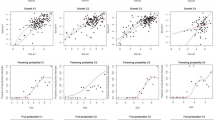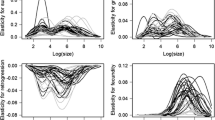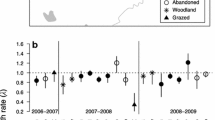Abstract
Demographic processes, such as survival, growth, and reproduction, can inform us about invasion risk, extinction risk, and trade-offs in life history strategies. The population dynamics of four Amaranthaceae species in southern Illinois, USA were examined using integral projection models (IPMs) to determine whether vital rates reflect life history among these closely related species. Two of the species, Amaranthus palmeri and Amaranthus tuberculatus, are summer annuals and considered to be some of the most problematic agricultural weeds in the US Midwest. Achyranthes japonica is a relatively new invasive exotic species that primarily inhabits forests. Iresine rhizomatosa, is an endangered species in the study area, which also inhabits forests. Two populations of each species were studied from 2012 to 2014 in which height of individuals were measured and used as the state variable in the IPMs. The Amaranthus species and Achyranthes japonica had an estimated population growth rate >1, projecting increases in population size. By contrast, λ was <1 for I. rhizomatosa, projecting a decline in population size demonstrating its endangered status. Germination rates and seed viability were dependent on species and varied over time. Elasticity analyses showed that survival and growth contributed most to λ for the perennial species; whereas, for the annual species population dynamics were driven primarily by fecundity. Overall, Achyranthes japonica and the Amaranthus species show similar trends in demographic processes that align with their invasive nature and not with their life histories. Furthermore, this study demonstrates that more research on the competitive nature of Achyranthes japonica is needed.




Similar content being viewed by others
References
Baker HG (1965) Characteristics and modes of origin of weeds. In: Baker HG, Stebbins GL (eds) The genetics of colonizing species. Academic Press, New York, pp 147–172
Bazzaz FA (1986) Life history of colonizing plants. In: Mooney HA, Drake JA (eds) Ecology of biological invasions of North America and Hawaii. Springer-Verlag, New York, pp 96–108
Boutin C, Harper JL (1991) A comparative study of the population dynamics of five species of Veronica in natural habitats. J Ecol 79:199–221
Childs DZ, Rees M, Rose KE, Grubb PJ, Ellner SP (2004) Evolution of size-dependent flowering in a variable environment: construction and analysis of a stochastic integral projection model. Proc R Soc Lond B 271:425–434
Choi CY, Nam HY, Chae HY (2010) Exotic seeds on the feathers of migratory birds on a stopover island in Korea. J Ecol Field Biol 33:19–22
Crawley MJ (2013) The R book, 2nd edn. Wiley, UK
Easterling MR, Sp Ellner, Dixon PM (2000) Size-specific sensitivity: applying a new structured population model. Ecology 81:694–708
Evans C, Taylor DD (2011) New invader profile: Japanese chaff flower Achyranthes japonica. Wildland Weeds Summer/Fall:4–6
Ferrer-Cervantes ME, Méndez-Gonzáles ME, Quintana-Ascencio PF, Dorantes A, Dzib G, Durán R (2012) Population dynamics of the cactus Mammillaria gaumeri: an integral projection model approach. Popul Ecol 54:321–334
Gibson DJ, Schwartz LM (2014) Population dynamics of endangered Iresine rhizomatosa (Juda’s bush). Grant Agreement No.: 13-026W Final Report to Illinois Department of Natural Resources. http://opensiuc.lib.siu.edu/cgi/viewcontent.cgi?article=1004&context=pb_reports. Accessed 20 March 2014
Grime JP (1979) Plant strategies and vegetation processes. John Wiley & Sons, New York
Guo P, Al-Khatib K (2003) Temperature effects on germination and growth of redroot pigweed (Amaranthus retroflexus), Palmer amaranth (A. palmeri), and common tall waterhemp (A. rudis). Weed Sci 51:869–875
Hartzler RG, Buhler DD, Stoltenberg DE (1999) Emergence characteristics of four annual weed species. Weed Sci 47:578–584
Horak MJ, Loughin TM (2000) Growth analysis of four Amaranthus species. Weed Sci 48:347–355
IDNR (Illinois Department of Energy and Natural Resources) (1994) The changing Illinois environment: Critical trends. Summary Report and Volumes 1-7 Technical Report. Illinois Department of Energy and Natural Resources, Springfield, Illinois
Merow C, Latimer AM, Wilson AM, McMahon SM, Rebelo AG, Silander JA Jr (2014) On using integral projection models to generate demographically driven predictions of species’ distributions: development and validation using sparse data. Ecography 37:1167–1183
Metcalf CJE, McMahon SM, Salguero-Gómez R, Jongejans E (2013) IPMpack: an R package for integral projection models. Methods Ecol Evol 4:195–200
National Weather Service (2015) National weather forecast office: Paducah, KY. http://www.weather.gov/climate/index.php?wfo=pah. Accessed 7 Jan 2015
Sage RF, Sage TL, Pearcy RW, Borsch T (2007) The taxonomic distribution of C4 Photosynthesis in Amaranthaceae sensu stricto. Am J Bot 94:1992–2003
Sakai AK, Allendorf FW, Holt JS, Lodge DM, Molofsky J, With KA, Baughman S, Cabin RJ, Cohen JE, Ellstrand NC, McCauley DE, O’Neil P, Parker IM, Thompson JN, Weller SG (2001) The population biology of invasive species. Annu Rev Ecol Syst 32:305–332
Schwartz LM (2014) Japanese chaff flower: a rising threat to southern Illinois. River to river cooperative weed management area. http://rtrcwma.blogspot.com/2014/05/japanesechaff-flower-rising-threat-to.html. Accessed 1 May 2015
Schwartz LM, Gibson DJ, Young BG (2016) Life history of Achyranthes japonica (Amaranthaceae): an invasive species in southern Illinois. J Torrey Bot Soc. doi:10.3159/TORREY-D-14-00014
Simberloff D, Schmitz DC, Brown TC (1997) Strangers in paradise: impact and management of non-indigenous species in Florida. Island Press, Washington D.C
Sutherland S (2004) What makes a weed a weed: life history traits of native and exotic plants in the USA. Oecologia 141:24–39
Trucco F, Tranel PJ (2011) Amaranthus. In: Kole C (ed) Wild crop relatives: genomic and breeding resources. Springer-Verlag, Berlin, pp 11–21
USDA Soil Survey (2015) Soil survey. United States Department of Agriculture: natural resources conservation service. http://websoilsurvey.sc.egov.usda.gov/App/WebSoilSurvey.aspx. Accessed 18 Feb 2015
Vitousek PM, D’Antonio CM, Loope LL, Westbrooks R (1996) Biological invasions as global environmental change. Am Sci 84:468–478
Zimdahl RL (2004) Weed-crop competition: a review. Blackwell Publishing, Ames
Acknowledgments
We would like to thank Southern Illinois University Carbondale and the Departments of Plant Biology and Plant Soil and Agricultural Systems for their support, Julie Young and Joseph Matthews for help with general organization, several undergraduate assistants helped to collect and process samples, and Maria Paniw for editing early versions of this manuscript. In addition, we would like to thank the Max Planck Institute for Demographic Research for teaching us the foundations of IPMs and the Illinois Department of Natural Resources for providing funding (Grant Agreement No.: 13-026W) to work with I. rhizomatosa.
Author information
Authors and Affiliations
Corresponding author
Electronic supplementary material
Below is the link to the electronic supplementary material.
Rights and permissions
About this article
Cite this article
Schwartz, L.M., Gibson, D.J. & Young, B.G. Using integral projection models to compare population dynamics of four closely related species. Popul Ecol 58, 285–292 (2016). https://doi.org/10.1007/s10144-016-0537-2
Received:
Accepted:
Published:
Issue Date:
DOI: https://doi.org/10.1007/s10144-016-0537-2




